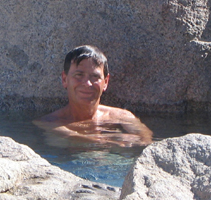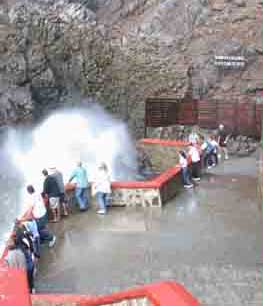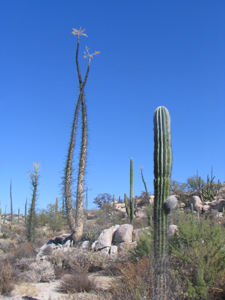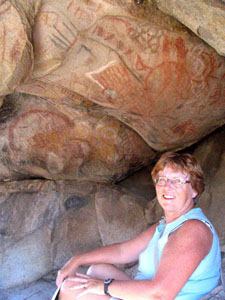Each campsite was totally secluded. Ours had a sheltered area for the tent, a half-walled, covered kitchen area with a stone work table, counter and sink, a picnic table and a private hot tub fed by mineral hot springs. Truly the most impressive campsite we have ever had. We spent 2 days there, resting, reading, and soaking in the hot tub. On the second day, we ventured out on a one 1 hr hike to a small waterfall in the canyon. At night, with no lights for miles, the stars were amazing!

Thursday we returned to Tecate in only about 4 ½ hours: 50 minutes on the rocks, 2½ hours on the dirt & washboard and 1+ hours on the highway. We were able to travel faster because we took about 15 lbs of air out of each tire to reduce the washboard effect.

From Tecate, we started south to Ensenada through the interior mountain range to some lush vineyards and market garden lands. Ensenada is on the Pacific coast about 100 km south of Tijuana and is a popular weekend destination for Americans, a cruise ship stop and the major Immigration Office for the Baja. We stayed in a hotel where we checked our e-mail and wandered around the stores. There was an excellent choice of restaurants too, which was a nice break from camp cooking.
The next day, we went along the coast to some of the new development areas and then went to La Bufadora, a sea geyser or blowhole in the rocks that spouts water up to 60 feet into the air. The name La Bufadora translates to "buffalo snort".
Later, we went golfing at a beautiful course that is bordered by a new condo development. As it turned out, that was our last golf game on the trip.
For the rest of the trip, we hit army roadblocks about every 100 - 150 km. They were quite intimidating - soldiers with machine guns, bunkers at the entrance and exit and spiked chains at the bunkers that the soldier could drag across the road if you didn't stop. We were eventually told that they were looking for drugs going north and guns going south. I guess we didn't look suspicious as they were very friendly and usually waved us through. They only stopped us once to look under the seats and in the glove compartment.
We expected that the whole trip would be barren desert but the area around Ensenada was very fertile; full of vineyards, and market gardens. After 100 km , it became rockier with ranches rather than farms and after another 100 km we got into true desert landscape: rocks, sand, cacti and sagebrush. Since there wasn't a lot to look at, we studied the cacti. Apparently, our guide book writer had the same problem so had long sections on the local flora.


We went about 400 km before stopping for the night in Cataviña, a truck-stop type village in the middle of the desert. It actually had a basic but lovely hotel, the La Pinta, which was one of a chain built by the government along the highway in the 1970's to encourage travellers. Sunday morning we visited a nearby rock-art site – Indian rock paintings about 4000 years old. We lucked out – just as we were arriving, a young archaeologist specializing in the Baja arrived to show the rock-art to friends he had been holidaying with. We tagged along with him and got all kinds of additional insight into them. According to him:
-
this site was about 4000 years old
-
most cave art was done in areas where there were hallucinogenic plants nearby so we shouldn't expect it to make sense
-
most had some pubescent symbols (usually phallic) signaling the use of the cave for right of passage
-
this site has yellow which was uncommon due to the scarcity of the chemicals needed to produce it (magnesium?)
Just before Guerrero Negro, we crossed the state border from Baja California Norte to Baja California Sur. There they confiscated the grapes I had bought that morning and charged us 10 pesos to spray the car with a pesticide. No northern bugs allowed!